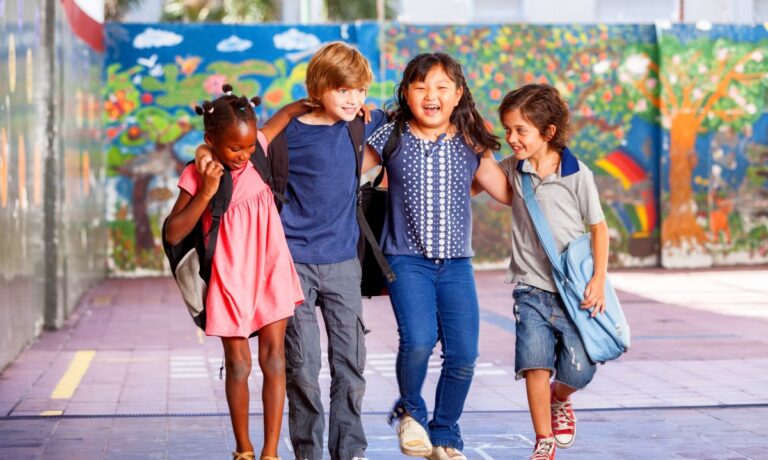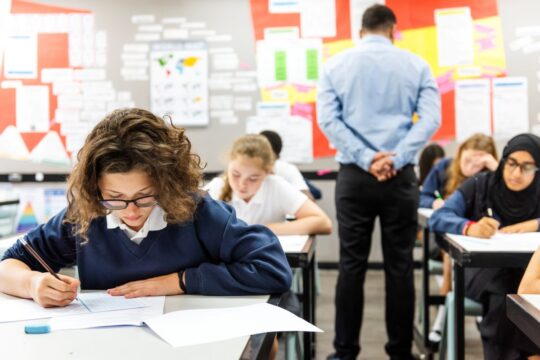Multicultural education is much more than celebrating Black History Month and learning about Passover. It’s about embracing diversity and addressing the cultural differences that shape our world. Teachers can help shift those perspectives by offering an cultural diversity in the classroom that integrates all cultures. This approach helps every child to be confident in their identity, as well as develop a deeper understanding of others with unique attributes.
In today’s multicultural society, it is essential to work cooperatively with all races, genders, and cultural backgrounds. Schools play an intricate role in helping children understand these differences through cross-ethnic interactions and various strategies.
Here are a few ways to get started.
How to Celebrate Cultural Diversity in the Classroom
Bring Culture into All Subjects
Culture doesn’t just belong in social studies. It should show up in the little moments, in all subjects, all year long. When you look at your lessons through a wider lens, you’ll start to see just how many chances you have to make learning more inclusive and meaningful.
Math is a great place to start. Talk about number systems used in other parts of the world or how ancient cultures like the Maya or Egyptians used math in everyday life. You’re not changing your entire lesson, but just adding a layer that shows students math looks different across time and place.
Science can easily include examples from around the world. Bring up how Indigenous communities use their deep understanding of nature to care for the land. Highlight scientists from different backgrounds so your students see that science is shaped by many voices, not just the ones in the textbook.
Writing is a perfect space for students to connect with who they are. Give them prompts that ask them to write about a family tradition, a celebration, or even a recipe that matters to them. Let them interview someone at home or tell a story about their culture. This is how they start to see that their voices and the voices of others truly matter.
You don’t need to wait for a special month or a themed bulletin board. When culture diversity in the classroom is part of your everyday teaching, students learn to value it as something real and important, not just something to “cover.”
Integrate Current Events
While textbooks are great for learning about historical information, they often lack current information. Try supplementing your curriculum by incorporating current events. By taking current news stories and intertwining them with the past, you create a parallel between the two. This is a great way for students to learn about cultures around the world, as well as celebrate the diversity of today.
Challenge students to create a project that requires them to learn about a culture other than their own. Encourage them to use current events or situations and research them. Pair students who come from different backgrounds or who aren’t close friends. The exposure to these different language cultures will be quite an eye-opening experience for all students.
Use Cooperative Learning
One of the most effective strategies that has been proven to embrace cultural diversity in the classroom is cooperative learning. This approach groups students not just by academic performance, but also by race, gender, and language proficiency. Students work together in small groups to complete various tasks that require students to work together as a team to achieve academic success.
Studies have found that through the use of these cooperative learning groups, children become more accepting of others’ differences. It has also been found to have positive effects on children from culturally diverse backgrounds. Because this strategy requires social interaction among students, it has the potential to reduce stereotyping and build diverse friendships across lines of difference.
Working together to complete a common goal allows children to judge one another by the quality of their work, not by stereotype. While it may take some time for students to develop cooperative behaviors, such as listening and acceptance, eventually students’ social interactions will become more positive and inclusive.
Through Role Play
Role-playing allows children to trade places with another student or a character from a book and learn about their culture. It encourages them to examine their own beliefs and feelings while gaining insight into the experiences of others. Through role-playing, children express their opinions and beliefs and learn that there are values and certain behaviors that are associated with different cultures.
This technique gives students empathy, so they gain a deeper understanding of what it is like to be in another person’s shoes. To make role-playing a meaningful experience, make sure students research and prepare for their role ahead of time. Their enactments should represent a clear portrayal of the intended person or culture they are trying to be. Done thoughtfully, this can be an opportunity that students will carry with them forever.
Choose Words That Make Everyone Feel Like They Belong
It’s not just what you teach, it’s how you talk about it. The language you use every day sends a message to your students about who belongs and who doesn’t. From the posters on your wall to the way you lead a class discussion, your words matter.
Try to keep your language inclusive so it reflects all types of families and experiences. Instead of always saying “mom and dad,” say something like “your grown-ups” or “someone at home.” When you talk about beliefs or traditions, saying “some people” or “in some cultures” helps keep things open and respectful.
And when a student shares something unfamiliar, lead with curiosity. Ask questions and let them be the expert. That kind of openness sets the tone for a classroom where everyone feels safe to be themselves and proud of where they come from.
Successful learning in a multi-cultural classroom requires an intercultural approach. One where students can experience and understand all perspectives. Use the strategies mentioned above to help students learn appropriate cultural behavior. Make your classroom an environment where students can expand their knowledge and look beyond each other’s differences. A place where all students’ unique backgrounds are understood.
You’ve got important career goals — we have the graduate program to get you there. Check out our available graduate degree programs to advance your career today!




